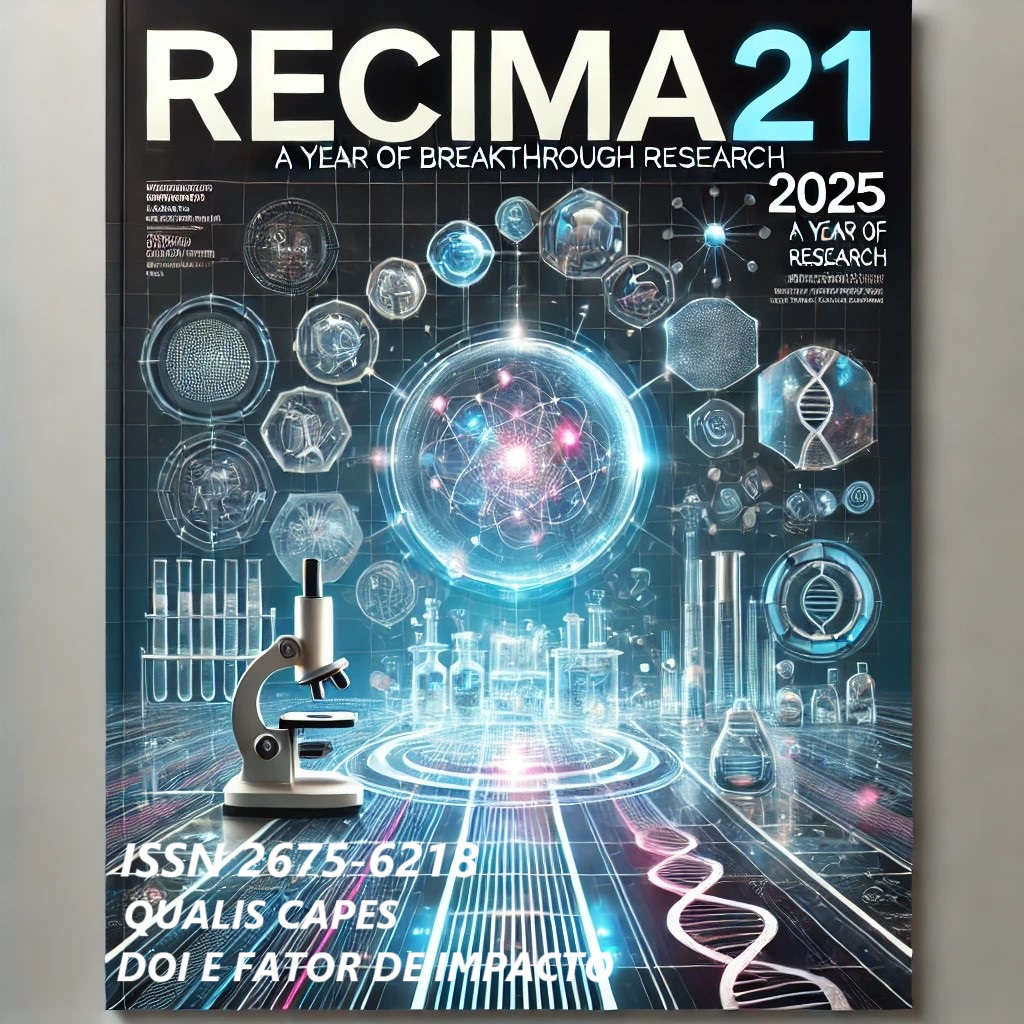THE USE OF ARTIFICIAL INTELLIGENCE IN ASSISTING ADULT TRIAGE IN EMERGENCY SERVICES
DOI:
https://doi.org/10.47820/recima21.v6i10.6821Keywords:
Artificial intelligence; Emergency triage; Emergency medicine; Health technology; Machine learning; Risk classification.Abstract
Objective: To analyze, through an integrative bibliographic review, how Artificial Intelligence (AI) can assist in risk classification of adult patients in emergency services, improving efficiency, accuracy and clinical outcomes. Method: An integrative literature review was conducted in MeSH, DeCs, VHL and SciELO databases using the descriptors "artificial intelligence", "emergency triage" and "adults". Articles published between 2019 and 2025, in Portuguese or English, addressing practical applications of AI in triage with quantitative performance data were included. Results: Eight studies were included in the final analysis. AI systems demonstrated significant reduction in classification time compared to manual methods, with algorithms such as neural networks showing superior sensitivity in detecting severe cases. The KATE model achieved 75.9% accuracy vs. 59.8% for nurses in ESI level assignment. Multimodal systems increased sensitivity by 10.94% for stroke detection. AI reduced median time from arrival to triage by 33%. Conclusion: AI shows promise in optimizing emergency triage, enhancing patient safety and resource allocation. However, its implementation requires ethical rigor, algorithmic transparency and adaptation to local realities, always maintaining qualified human supervision.
Downloads
References
1. Ahmed MI, Spooner B, Isherwood J, et al. A systematic review of the barriers to implementing artificial intelligence in healthcare. Health Policy Technol 2024;139(2):100758. doi:10.1016/j.healthpol.2024.100758 DOI: https://doi.org/10.7759/cureus.46454
2. Alowais SA, Alghamdi SS, Alsuhebany N, et al. Revolutionizing healthcare: the role of artificial intelligence in clinical practice. BMC Med Educ. 2023;23(1):689. doi:10.1186/s12909-023-04698-z DOI: https://doi.org/10.1186/s12909-023-04698-z
3. Ausserhofer D, Zaboli A, Pfeifer N, et al. Performance of the Manchester Triage System in patients with dyspnoea: a retrospective observational study. Int Emerg Nurs. 2020;3: 100931. doi:10.1016/j.ienj.2020.100931 DOI: https://doi.org/10.1016/j.ienj.2020.100931
4. Bajwa J, Munir U, Nori A, Williams B. Artificial intelligence in healthcare: transforming the practice of medicine. Future Healthc J. 2021;8(2):e188-e194, 2021. doi:10.7861/fhj.2021-0095 DOI: https://doi.org/10.7861/fhj.2021-0095
5. Bean DM, Kraljevic Z, Shek A, et al. Natural language processing data services for healthcare providers. BMC Med Inform Decis Mak. 2024;24(1):320. doi:10.1186/s12911-024-02713-x DOI: https://doi.org/10.1186/s12911-024-02713-x
6. Bekbolatova M, Mayer J, Ong CW, et al. Transformative potential of AI in healthcare: definitions, applications, and navigating the ethical landscape and public perspectives. Healthcare (Basel). 2025;12(2):125. doi:10.3390/healthcare12020125 DOI: https://doi.org/10.3390/healthcare12020125
7. Bordewich M, Hameed A, Woodcock C. AI system performance on cancer detection tasks: the impact of dataset composition. Artif Intell Med. 2024;147:102720. doi:10.1016/j.artmed.2023.102720 DOI: https://doi.org/10.1016/j.artmed.2023.102720
8. Cai T, Ni H, Yu M, Huang X, Wong K, Volpi J, Wang JZ, Wong STC. DeepStroke: an efficient stroke screening framework for emergency rooms with multimodal adversarial deep learning. Med Image Anal. 2022;80:102522. doi:10.1016/j.media.2022.102522 DOI: https://doi.org/10.1016/j.media.2022.102522
9. Cicolo EA, Nishi FA, Peres HHC, Da Cruz DDAL. Effectiveness of the Manchester Triage System on time to treatment in the emergency department: a systematic review. JBI Evid Synth. 2020;18(1):56-73. doi:10.11124/JBISRIR-2017-003825 DOI: https://doi.org/10.11124/JBISRIR-2017-003825
10. Cross JL, Choma MA, Onofrey JA. Bias in medical AI: implications for clinical decision-making. PLOS Digital Health. 2024;3(11):e0000651. doi:10.1371/journal.pdig.0000651 DOI: https://doi.org/10.1371/journal.pdig.0000651
11. De Micco F, Di Palma G. Ferorelli D, et al. Artificial intelligence in healthcare: transforming patient safety with intelligent systems—a systematic review. Front Med. 2025;11:1522554. doi:10.3389/fmed.2024.1522554 DOI: https://doi.org/10.3389/fmed.2024.1522554
12. Fonseca CG, Souza EN, Kuniyoshi RR, et al. Machine learning na medicina: revisão e aplicabilidade. Arq Bras Cardiol. 2021;116(4):695-704. doi:10.36660/abc.20200596 DOI: https://doi.org/10.36660/abc.20200596
13. Fraile Navarro D, Ijaz K, Rezazadegan D, et al. Clinical named entity recognition and relation extraction using natural language processing of medical free text: a systematic review. Int J Med Inform. 2023;177:105122. doi:10.1016/j.ijmedinf.2023.105122 DOI: https://doi.org/10.1016/j.ijmedinf.2023.105122
14. Helguera-Repetto AC, Yañez-Mo M, González-Muñoz M, et al. Neonatal sepsis diagnosis decision-making based on artificial neural networks. Front Pediatr. 2020;8:525. doi:10.3389/fped.2020.00525 DOI: https://doi.org/10.3389/fped.2020.00525
15. Ivanov O, Wolf L, Brecher D, et al. Improving ED Emergency Severity Index acuity assignment using machine learning and clinical natural language processing. J Emerg Nurs. 2021;47(2):265-278.e7, 2021. doi:10.1016/j.jen.2020.11.001 DOI: https://doi.org/10.1016/j.jen.2020.11.001
16. Jerfy A, Selden O, Balkrishnan R. The growing impact of natural language processing in healthcare and public health. Inquiry. 2024;61:469580241290095. doi:10.1177/00469580241290095 DOI: https://doi.org/10.1177/00469580241290095
17. Johnson KW, Torres Soto J, Glicksberg BS, et al. Artificial intelligence in cardiology. J Am Coll Cardiol. 2018;71(23):2668-2679. doi:10.1016/j.jacc.2018.03.521 DOI: https://doi.org/10.1016/j.jacc.2018.03.521
18. Kiblboeck D, Steinrueck K, Nitsche C, et al. Evaluation of the Manchester triage system for patients with acute coronary syndrome. Wien Klin Wochenschr. 2020;132(11-12):277-282. doi:10.1007/s00508-020-01632-x DOI: https://doi.org/10.1007/s00508-020-01632-x
19. Lauritsen SM, Kalør ME, Kongsgaard EL, Lauritsen KM, Jørgensen MJ, Lange J, Thiesson B. Early detection of sepsis utilizing deep learning on electronic health record event sequences. Artif Intell Med. 2020;104:101820. doi:10.1016/j.artmed.2020.101820 DOI: https://doi.org/10.1016/j.artmed.2020.101820
20. Li F, Jin Y, Liu W, et al. Fine-tuning bidirectional encoder representations from transformers (BERT)–based models on large-scale electronic health record notes: an empirical study. JMIR Med Inform. 2019;7(3):e14830. doi:10.2196/14830 DOI: https://doi.org/10.2196/14830
21. Lin PC, Chen KT, Chen HC, Islam MM, Lin MC. Machine learning model to identify sepsis patients in the emergency department: algorithm development and validation. J Pers Med. 2021;11(11):1055. doi:10.3390/jpm11111055 DOI: https://doi.org/10.3390/jpm11111055
22. Lynn LA. Artificial intelligence systems for complex decision-making in acute care medicine: a review. Patient Saf Surg. 2019;13:6. doi:10.1186/s13037-019-0188-2 DOI: https://doi.org/10.1186/s13037-019-0188-2
23. Morone G, De Angelis L, Martino Cinnera A, et al. Artificial intelligence in clinical medicine: a state-of-the-art overview of systematic reviews with methodological recommendations for improved reporting. Front Digit Health. 2025;7:1550731. doi:10.3389/fdgth.2025.1550731 DOI: https://doi.org/10.3389/fdgth.2025.1550731
24. Obermeyer Z, Powers B, Vogeli C, Mullainathan S. Dissecting racial bias in an algorithm used to manage the health of populations. Science. 2019;366(6464):447-453. doi:10.1126/science.aax2342 DOI: https://doi.org/10.1126/science.aax2342
25. Parikh RB, Teeple S, Navathe AS. Addressing bias in artificial intelligence in health care. JAMA. 2023;322(24):2377-2378. doi:10.1001/jama.2019.18058 DOI: https://doi.org/10.1001/jama.2019.18058
26. Peiffer-Smadja N, Dellière S, Rodriguez C, et al. Machine learning in the clinical microbiology laboratory: has the time come for routine practice? Clin Microbiol Infect. 2020;26(10):1300-1309, 2020. doi:10.1016/j.cmi.2020.02.006 DOI: https://doi.org/10.1016/j.cmi.2020.02.006
27. Poalelungi DG, Musat CL, Fulga A. et al. Advancing patient care: how artificial intelligence is transforming healthcare. J Pers Med. 2023;13(8):1214. doi:10.3390/jpm13081214 DOI: https://doi.org/10.3390/jpm13081214
28. Roppelt JS, Kanbach DK, Kraus S. Artificial intelligence in healthcare institutions: a systematic literature review on influencing factors. Technol Soc,. 2024;76:102443. doi:10.1016/j.techsoc.2023.102488 DOI: https://doi.org/10.1016/j.techsoc.2023.102443
29. Sartini M, Spada A, Bagattini B, et al. Overcrowding in emergency department: causes, consequences, and solutions - a narrative review. Healthcare (Basel). 2022;10(9):1625. doi:10.3390/healthcare10091625 DOI: https://doi.org/10.3390/healthcare10091625
30. Secinaro S, Calandra D, Secinaro A, Muthurangu V, Biancone P. The role of artificial intelligence in healthcare: a structured literature review. BMC Med Inform Decis Mak. 2021;21(1):125. doi:10.1186/s12911-021-01488-9 DOI: https://doi.org/10.1186/s12911-021-01488-9
31. Silva JA, Macedo ME, Santos MJ, et al. Emergency Severity Index: accuracy in risk classification. Einstein (São Paulo). 2017;15(4):421-427. doi:10.1590/S1679-45082017AO3964 DOI: https://doi.org/10.1590/s1679-45082017ao3964
32. Singh DP, Kaushik B. A systematic literature review for the prediction of anticancer drug response using various machine-learning and deep-learning techniques. Chem Biol Drug Des. 2023;101(1):175-194. doi:10.1111/cbdd.14164 DOI: https://doi.org/10.1111/cbdd.14164
33. Smith KP, Kang AD, Kirby JE. Automated interpretation of blood culture gram stains by use of a deep convolutional neural network. J Clin Microbiol. 2018;56(3):e01521-17. doi:10.1128/JCM.01521-17 DOI: https://doi.org/10.1128/JCM.01521-17
34. Souza CC, Chianca TCM, Cordeiro Júnior W, et al. A systematic review on the validity and reliability of an emergency department triage scale, the Manchester Triage System. Int J Nurs Stud. 2018;77:1-7. doi:10.1016/j.ijnurstu.2014.01.013 DOI: https://doi.org/10.1016/j.ijnurstu.2014.01.013
35. Storm-Versloot MN, Ubbink DT, Chin a Choi V, Luitse JS. Observer agreement of the Manchester Triage System and the Emergency Severity Index: a simulation study. Emerg Med J. 2009;26(8):556-560. doi:10.1136/emj.2008.059378 DOI: https://doi.org/10.1136/emj.2008.059378
36. Subramanian M, Wojtusciszyn A, Favre L, et al. Precision medicine in the era of artificial intelligence: implications in chronic disease management. J Transl Med. 2020;18(1):472. doi:10.1186/s12967-020-02658-5 DOI: https://doi.org/10.1186/s12967-020-02658-5
37. Sun L, Liu K, Zhang Y, et al. ED-Copilot: reduce emergency department wait time with language model diagnostic assistance. In: Proceedings of the 41st International Conference on Machine Learning. PMLR. 2024:46942-46956.
38. Tagliaferri SD, Angelova M, Zhao X, et al. Artificial intelligence to improve back pain outcomes and lessons learnt from clinical classification approaches: three systematic reviews. NPJ Digit Med. 2020;3:93. doi:10.1038/s41746-020-0303-x DOI: https://doi.org/10.1038/s41746-020-0303-x
39. Taylor RA, Moore CL, Cheung KH, et al. Impact of artificial intelligence-based triage decision support on emergency department care. NEJM AI. 2025;2(3). doi:10.1056/AIoa2400296 DOI: https://doi.org/10.1056/AIoa2400296
40. Tolu-Akinnawo O, Ezekwueme F, Awoyemi T. Telemedicine in cardiology: enhancing access to care and improving patient outcomes. Cureus. 2024;16(6):e62852. doi:10.7759/cureus.62852 DOI: https://doi.org/10.7759/cureus.62852
41. Ullah N, Mirza S, Haroon M, et al. Natural language processing in electronic health records in relation to healthcare decision-making: a systematic review. Comput Biol Med. 2023;155:106649. doi:10.1016/j.compbiomed.2023.106649 DOI: https://doi.org/10.1016/j.compbiomed.2023.106649
42. Ullah W, Ali Q. Role of artificial intelligence in healthcare settings: a systematic review. J Med Artif Intell. 2025;8:24. doi:10.21037/jmai-24-294 DOI: https://doi.org/10.21037/jmai-24-294
43. van der Meijden SL, Koumpouras F, Yucel O. et al. Intensive care unit physicians' perspectives on artificial intelligence-based clinical decision support tools: preimplementation survey study. JMIR Hum Factors. 2023;10:e39114. doi:10.2196/39114 DOI: https://doi.org/10.2196/39114
44. van der Wulp I, Schrijvers AJ, van Stel HF. Predicting admission and mortality with the Emergency Severity Index and the Manchester Triage System: a retrospective observational study. Emerg Med J. 2009;26(7):506-509. doi:10.1136/emj.2008.063768 DOI: https://doi.org/10.1136/emj.2008.063768
45. Vedana AB, Silva CA, Santos RD, et al. Inteligência artificial na medicina diagnóstica. Brazilian Journal of Implantology and Health Sciences. 2024;6(11):765-794. doi:10.36557/2674-8169.2024v6n11p765-794 DOI: https://doi.org/10.36557/2674-8169.2024v6n11p765-794
46. Weis CV, Jutzeler CR, Borgwardt K. Machine learning for microbial identification and antimicrobial susceptibility testing on MALDI-TOF mass spectra: a systematic review. Clin Microbiol Infect. 2020;26(10):1310-1317. doi:10.1016/j.cmi.2020.03.014 DOI: https://doi.org/10.1016/j.cmi.2020.03.014
47. Yadav N, Pandey V, Singh A, et al. Data privacy in healthcare: in the era of artificial intelligence. Indian Dermatol Online J. 2023;14(6):788-792. doi:10.4103/idoj.idoj_543_23 DOI: https://doi.org/10.4103/idoj.idoj_543_23
48. Yang X, Zeng X, Zheng W, et al. A large language model for electronic health records. NPJ Digit Med. 2022;5(1):194. doi:10.1038/s41746-022-00742-2 DOI: https://doi.org/10.1038/s41746-022-00742-2
49. Zachariasse JM, Seiger N, Rood PP, et al. Validity of the Manchester Triage System in emergency care: a prospective observational study. PLoS One. 2017;12(2):e0170811. doi:10.1371/journal.pone.0170811 DOI: https://doi.org/10.1371/journal.pone.0170811
50. Zakeri H, Afshari Saleh L, Niroumand S, Ziadi-Lotfabadi M. Comparison the Emergency Severity Index and Manchester Triage System in trauma patients. Bull Emerg Trauma. 2022;10(2):65-70. doi:10.30476/BEAT.2022.92297.1302
Downloads
Published
License
Copyright (c) 2025 RECIMA21 - Revista Científica Multidisciplinar - ISSN 2675-6218

This work is licensed under a Creative Commons Attribution 4.0 International License.
Os direitos autorais dos artigos/resenhas/TCCs publicados pertecem à revista RECIMA21, e seguem o padrão Creative Commons (CC BY 4.0), permitindo a cópia ou reprodução, desde que cite a fonte e respeite os direitos dos autores e contenham menção aos mesmos nos créditos. Toda e qualquer obra publicada na revista, seu conteúdo é de responsabilidade dos autores, cabendo a RECIMA21 apenas ser o veículo de divulgação, seguindo os padrões nacionais e internacionais de publicação.













